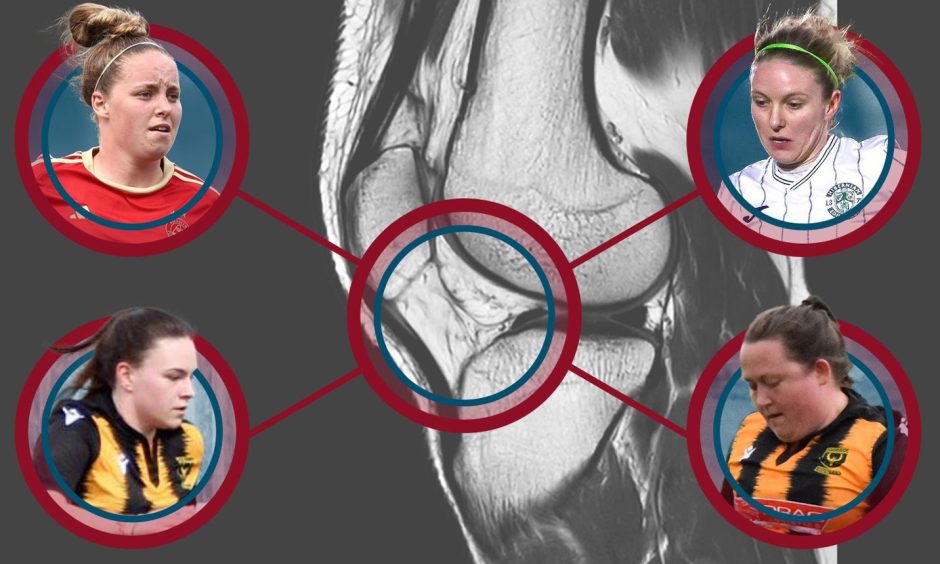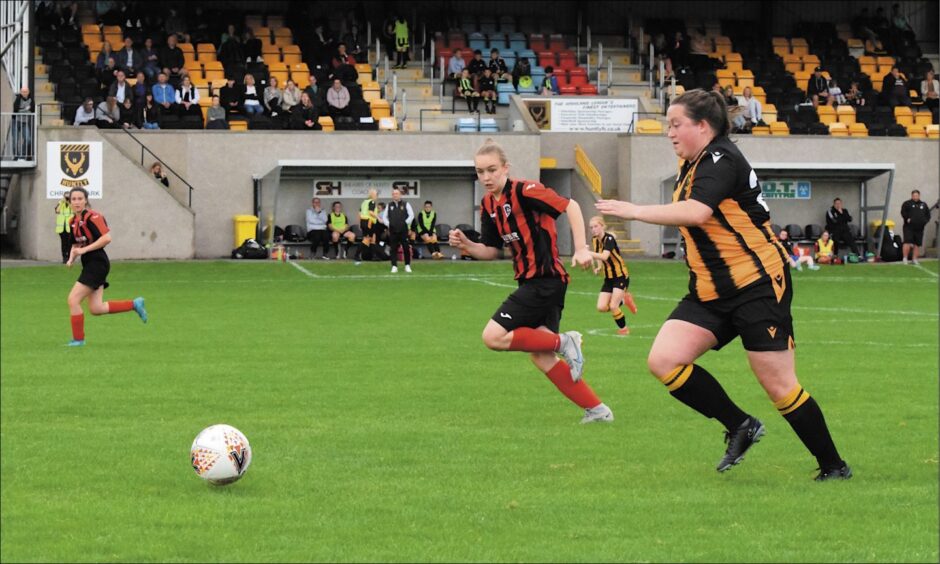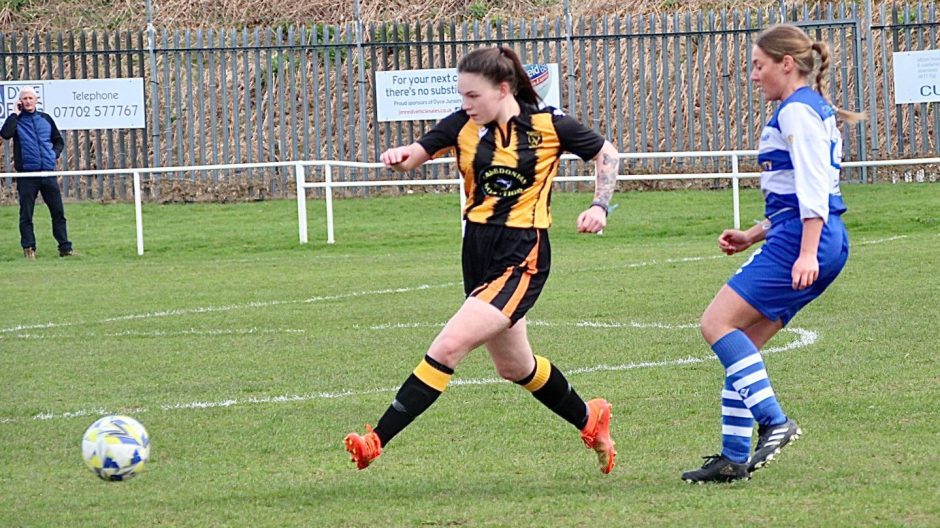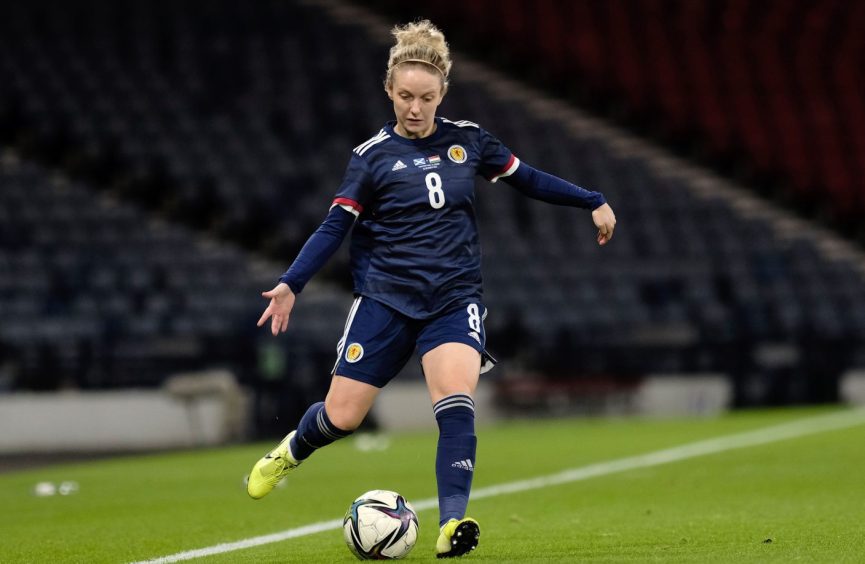
ACL injuries and women’s football have become synonymous with one another in recent times – and a special investigation from The Press and Journal has uncovered how the issue is affecting players from the north of Scotland.
The ACL is a ligament in the knee which keeps the knee stable and and stops the thigh and shin bones moving out of place.
An injury can be a complete tear, a stretched ligament, or a detachment of the ligament from the bone – and can be done by twisting the knee, changing direction, slowing down while running, overextension, or in a collision, such as a challenge from an opponent.
An athlete will often be out for between nine to 12 months after sustaining the injury, which for a footballer can often mean missing an entire season.
Why are there so many ACL injuries in women’s football?
There are links between the menstrual cycle and an increase in risk of injury.
Answers on the impact of the environment female footballers work in – such as the schedule and the pitch facilities – have also been sought, while research on the impact of the sport – as football has been traditionally purposed with men in mind – on the female body would certainly be advantageous.
The injury does not discriminate and affects grassroots players to world-class stars.
Scotland’s Caroline Weir and England captain Leah Williamson are just two of several women’s football superstars currently ruled out with ACL injuries, while Arsenal’s Beth Mead and Vivianne Miedema have both just returned almost a year on since being stretchered off.
The Press and Journal spoke to four current players, who either play in or are from the north of Scotland, who shared their experiences of coping and recovering from the injury.
All of the players: Aberdeen’s Laura Holden, Hibernian’s Rachael Boyle – who hails from Northfield – and Huntly’s Laura Parsley and Kaylah Cruickshank, agreed the pain they experienced when the injury happened was like nothing they had felt before.
Players having to seek NHS treatment for ACL injuries
Parsley, 27, is the only player to have made her return to playing from the injury, having hurt her ACL around five years ago while playing for Dundee United.
Many female footballers like Parsley, especially those who do not play for a professional or semi-professional team, have to seek treatment through the NHS.
It was not a positive experience for the Huntly striker and something which still frustrates her to this day.
She recalls having to wait months for an MRI scan after an initial X-ray in A&E confirmed her leg was not broken.
Parsley’s wait for surgery after getting injured was around eight months.
The recovery was traumatic and the injury has continued to haunt Parsley ever since she has returned to playing.
“It was about two years after the injury that I played my first game,” said Parsley. “It was with RGU (Robert Gordon University).
“If it wasn’t for Ailsa Harper (team-mate) I don’t think I would have been back as soon as I was.
“She was the one who said to me: ‘You’ve had the surgery and you’ve done the rehab’ – because I was scared about doing it again and couldn’t see past that.
“For the longest time, I was taping my knee up just for the sake of taping it up and a lot of that was just down to the mental side of it.
“I thought if it was taped then I would be fine. It wasn’t until I joined Huntly when I stopped doing that and that’s about five years on from when I did my ACL.
“Even now I know that if it doesn’t feel right when I wake up in the morning that I need to stretch it properly or ice it.
“It is still a fear every time I step out on the pitch.”
Long waiting time and lack of care leaves many to feel ‘let down’
Parsley’s experience with the public healthcare system is unfortunately shared by her Huntly team-mate Cruickshank, who got injured in April and says the reality of it all has still not sunk in yet.
Like Parsley, the teenage winger feels let down by the care – or lack of – she has received so far in her rehab.
She is still waiting to be seen by a consultant eight months on.
After an initial GP appointment, she has since received a letter acknowledging she is on the waiting list.
Reflecting on the day the injury happened, Cruickshank told the P&J how, despite being in excruciating pain, she had to walk from the pitch to the ambulance.
The prognosis from the paramedics was a “bruised knee”, and as Cruickshank did not think the damage was as bad as it was, she went back to training not long after – where her knee gave way again.
For now, she is still attending training – but not participating – to be around her team-mates and has taken up swimming to help keep the mobility in her knee.
Cruickshank accepts injuries are part and parcel of football, but strongly believes the pitch conditions played a part in her experience.
“I went down and think it was the way I landed because my knee went into the astroturf pitch,” explained Cruickshank.
“It was the worst pain I have ever had. It was a shooting pain from my knee and right up my leg.
“I think it was because of playing on astroturf – if I had been playing on grass my knee would have slid when I fell rather than just sink into the pitch.”
ACL lay-off time is similar to that of having a child
Meanwhile, Hibernian’s Boyle, 31, is hoping to return from her injury later this season, having been out since February.
Her injury came at the worst possible time as she had only just made her comeback after being sidelined for 12 months after giving birth to her second daughter.
The high of scoring two goals in her first game back soon turned into the low of Boyle being stretchered off, which immediately left her heartbroken as she knew she was set for another lengthy spell out.
The 43-times capped Scotland international’s rehab has not been plain-sailing, with many lonely days in the gym and getting back playing has at times felt so far away.
But fortunately in recent weeks there has been more progression than setbacks for Boyle, who would like to see more research go into ACL injuries in women’s football.
“Knowledge is power,” said Boyle. “The more you know about things, the better you can handle it. The more research we can get the better.
“There are so many factors which could go into it, and while it might be difficult to pinpoint why women are more susceptible, knowing more would mean we could put certain measures in place to try and safeguard players as much as we can.
“We can never stop injuries.
“It’s an unfortunate part of the game, but if we can reduce the risk and prolong people’s careers then that would certainly benefit the sport.”
Boyle admits she was not fully fit when she returned, but, like she did after having her first child, she felt getting minutes under the belt was the best way to build up her fitness.
“For me, personally, it has been more difficult purely down to the fact I was out for a year prior to the injury having had my daughter,” said Boyle
I had gone through my whole career without having any serious knee problems.” – Rachael Boyle
“To come back from that – and to be perfectly honest with myself – I wasn’t fully fit when I came back.
“Whether or not my body was ready for that or whether the injury was just one of these things that was going to happen – I don’t know.
“But the fact that I wasn’t fully fit and strong as what I should have been probably didn’t help.
“There is no regret about coming back when I did – especially because in my first game back I scored two goals and had my daughters in the stand. That was an amazing day.
“I knew it was where I wanted to be and it was going to be the starting block.
“When I had my first daughter, I had done the same, and I came back playing and that’s where my fitness and sharpness really come back.
“The way I look at it is that it was bound to get a serious injury like this at some point. I had gone through my whole career without having any serious knee problems.
“I feel quite fortunate for that because I know girls who have done it two, three or even four times.”
Having a contract is a solace for injury sufferers
Holden, who moved to Aberdeen this summer from Bristol in a life-changing move, knows her story would have been different if she was not under contract at the Dons.
Holden is currently one of nine women’s players who are employed by the Reds through semi-professional contracts.
The 22-year-old midfielder injured her ACL 30 minutes into a SWPL match against Hibs.
There have been stories of female players with ACL injuries, recently reported by The Athletic, being left with no club after getting injured – which leaves them unemployed and no access to private rehab facilities.
While she shouldn’t have to consider herself lucky, Holden admits having the security of a two-year deal took a considerable weight off her shoulders.
“It would be a completely different story if I wasn’t contracted or if I didn’t have the opportunity to stay at the club for a couple of years,” said Holden.
“After it happened, Clint (Lancaster, Aberdeen Women’s boss) said: ‘Thank god we went for a two-year deal’, because it would have been a completely different story – and I’m very grateful for that.”
Since being sidelined Holden has stayed around the team, which has helped her stay positive as possible.
However, at the time of speaking, Holden admits at feeling in “limbo” due to waiting for surgery.
“The worst thing you can do with long-term injuries is hide away and not speak to anyone – you can’t go through this by yourself,” added Holden.
“It is so important to talk about things and to let people know if you are struggling.
“I’ve still been part of the team – going to training and matches – and that’s all I wanted when I knew I was going to be out for a long time.
“It’s the highlight of my day when I go to training. Although it is difficult to watch the girls because I want to be out there with them.
“It’s very much still being involved that matters. I don’t have to feel like I am alone.”




Conversation